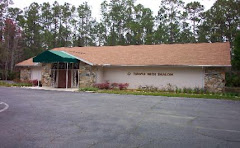
 Temple Beth Shalom young people were well prepared with their flags for marching with the Torah Scrolls as the annual cycle of readings from the Five Books of Moses were completed in the synagogue's sanctuary.
Temple Beth Shalom young people were well prepared with their flags for marching with the Torah Scrolls as the annual cycle of readings from the Five Books of Moses were completed in the synagogue's sanctuary. Until sometime between the ninth and 12th centuries (depending on whose history you accept), different parts of the Jewish world followed different cycles of reading the Torah. Then the triennial system [of reading the entire Torah in three-year cycles] ending before Pesach used in Palestine was dropped in favor of Babylon's annual cycle, with the last portion of Deuteronomy assigned as the portion for the secondday of Shemini Atzeret.
In connection with the reading, it became customary to remove the Sifrei Torah from the Ark and circle around the bimah [pulpit], a ceremony for which hundreds of prayers were composed (also called hoshanahs, forthe last word of each prayer). Named Simchat Torah, Rejoicing of the Torah, the occasion was soon accompanied by vivacious dancing and hymn singing in synagogue and lavish festival meals at home.
The impetus for the exuberant support of and adherence to Torah was provided by persecutions of the 14th century, when expulsions, blood libels, and Crusades were directed against Jews who refused to forsake the text.
With symbols and activities of marriage, such as a service suggesting the wedding of Israel to the law, the celebrations demonstrated that the Jews' devotion was unflagging and their feeling insuppressible. (The British diarist Samuel Pepys noted, in rather disdainful terms, the carryings on in a London synagogue in 1663, in disbelief that he was watching a "decent" religious community. The congregation later regulated itself to display greater decorum.)
Soon it became customary to immediately turn to the beginning of the Torah and start the reading cycle again, expressing the desire to continually study the sacred guidebook. Due to its nature, the new holiday superseded the biblically ordained and much more subdued Shemini Atzeret.
Temple Beth Shalom young people made their own flags, joined in the singing and dancing with the Torah scrolls and were first in line for the candy following synagogue services, symbolizing the sweetness of the words of the Torah.

No comments:
Post a Comment